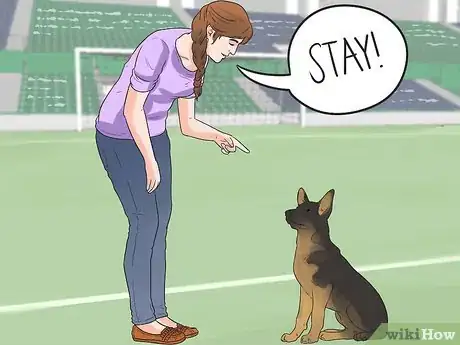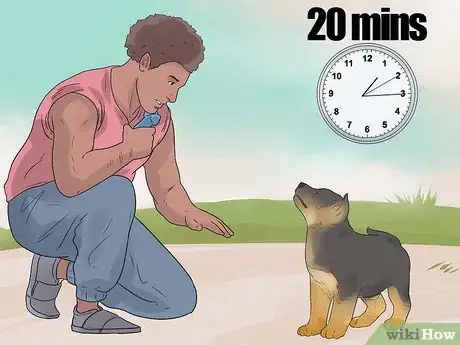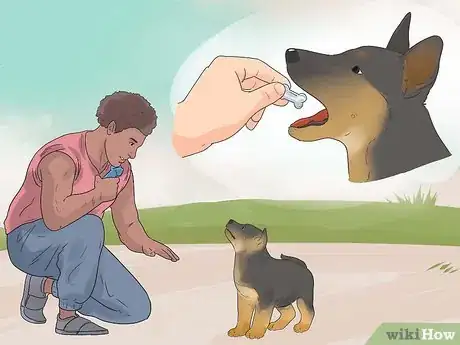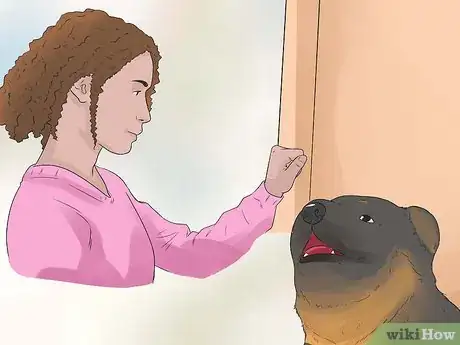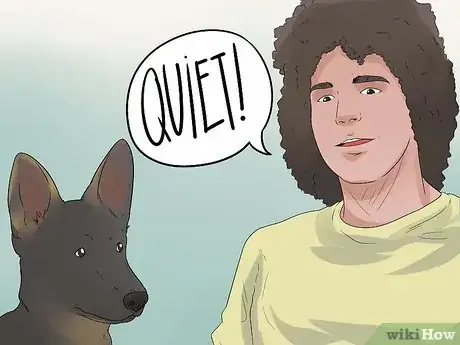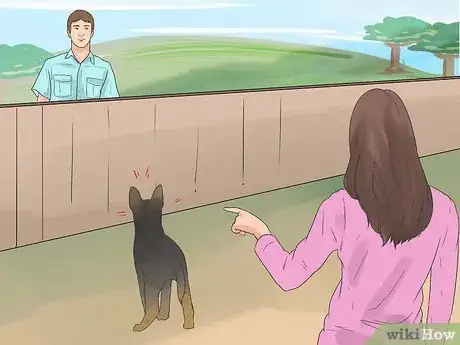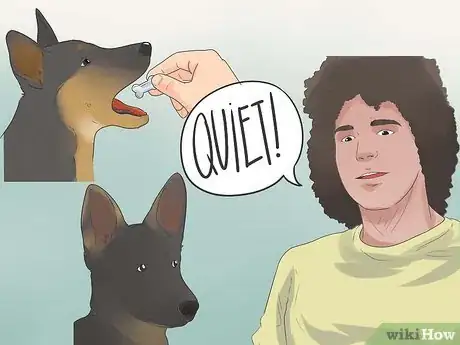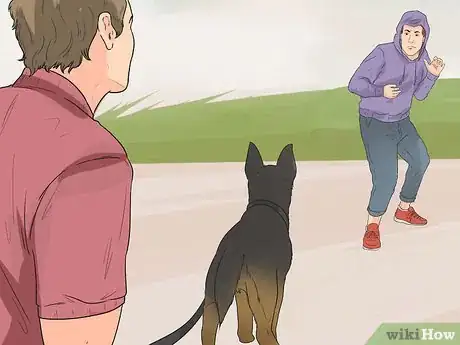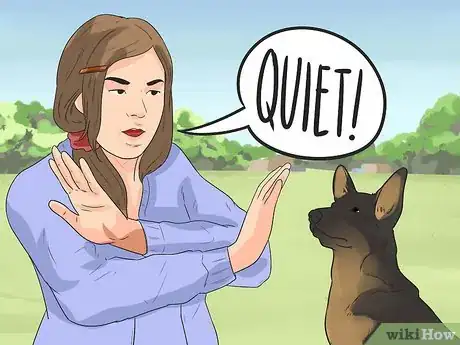This article was co-authored by Lauren Novack. Lauren Novack is a Certified Dog Behavior Consultant at Behavior Vets NYC where she helps fearful, anxious, and aggressive pets and their owners. She has completed coursework for her MS in Applied Behavior Analysis at Hunter College. Lauren’s research explores the intersection between training practices and animal welfare. She currently serves on the Editorial Advisory Board for Daily Paws and has appeared on Fox & Friends, Rachel Ray, and various news outlets with her dog Grayson.
wikiHow marks an article as reader-approved once it receives enough positive feedback. In this case, 86% of readers who voted found the article helpful, earning it our reader-approved status.
This article has been viewed 47,406 times.
German shepherds are intelligent dogs that have an intimidating presence and a loud bark, which gives them the potential to be great guard dogs. But turning a German shepherd into a guard dog takes lots of time, patience, and hard work. You will need to work with your German shepherd every day to help him develop good obedience as well as confidence in his guarding abilities. Since training a dog is time-consuming and often challenging, you may also want to seek the help of a certified professional dog trainer.
Steps
Building a Strong Foundation
-
1Socialize your German shepherd when he is a puppy. In order to have a well-trained guard dog, you will need to start socializing your German shepherd from a young age.[1] Puppies are more receptive to new things until they are about 18 weeks old. During this time, the things that they see, hear, and smell are less frightening. It is important to make sure that your German shepherd puppy is well-socialized during this time so that he will confident rather than anxious or fearful.[2]
- To socialize your puppy, make sure that you expose the puppy to all sorts of different situations. Walk him past schools when kids are around, walk beside busy roads, take him out in the rain to see people with umbrellas, expose him to a vacuum cleaner and hair dryer, and introduce him to lots of other types of dogs and people. Try to make the experiences as wide and varied as you can.[3]
-
2Find a dog trainer or obedience course. To teach your German shepherd to be a guard dog, he will need to be well-behaved and you will need to train with him every day.[4] The best way to go about this is to find a good trainer or obedience course to help you. Look for a dog trainer or training class in your area that uses modern, well-informed methods of training based on either clicker training or reward-based training.[5]
- Clicker training is a method of training that marks positive behavior with a clicking sound. Trainers who use this method also use rewards such as treats and praise, but the clicker helps to mark good behavior.[6]
- Reward-based training uses praise, treats, and other things that will motivate your dog to follow your commands.
- Do not use old-fashioned methods of dominating a dog, such as alpha-rolls or scruffing techniques. These methods are outdated and ineffective.
Advertisement -
3Teach your German shepherd to follow basic commands. Before your German shepherd can become a guard dog he needs to learn how to listen and respond to your commands. That is why it is a good idea to start with basic training commands such as sit, stay, and come back. Once your German shepherd has mastered basic commands, he will be ready to take on more challenging ones.
-
4Take good care of your German shepherd.[7] Make sure your dog is well cared for, fed good quality food, and receives plenty of exercise. You want the dog to be fit and mentally stimulated. A bored, out of condition dog is more likely to overreact in the face of an intruder, which may lead to one of your friends or neighbors getting injured.
-
5Develop a regular training routine. Train your dog daily, ideally in two to three sessions a day. Each session varies in length depending on the attention span of the individual dog, but German shepherds are often capable of being trained for 20 minutes at a time.[8]
-
6End each training session on a positive note. Your German shepherd will enjoy training more if it always ends with a treat and some praise. If your German shepherd starts to make mistakes, bring the lesson to a close with a simple command that you know the dog is capable of doing. That way you will be able to reward him and end the session on a positive note.
Teaching the Speak and Quiet Commands
-
1Teach your German shepherd to bark. Make a noise that will make your dog bark, such as knocking on the door. After he starts barking, praise your dog and give him a reward. By following up his behavior with some praise, you will be letting your dog know that his behavior is good.[9]
-
2Label the behavior. Next, add a cue or label to the barking, such as “Speak.” Say this cue the next time you tap on the door to help your dog associate the behavior with the word. Make sure that you reward and praise him as well.
-
3Reward him for being quiet. When your dog stops barking, praise and reward him so he knows that being quiet is also good. If your dog does not stop barking, then you can distract him with a few small treats until he quiets down. Feed him pieces of a cut-up hot dog or some other small treat one at a time to keep him quiet.[10]
-
4Name the behavior. The next time that you practice this command with your German shepherd, add the word "Quiet" to help him associate the behavior with the word. When German shepherd stops barking, then say “quiet” as soon as he stops and the give him his reward and praise.
- If your dog needs to be distracted with treats, then say “quiet” as you are feeding him the treats.[11]
-
5Reinforce both of these commands by constant repetition. You will need to practice these commands with your German shepherd every day so that he will understand what you want him to do. Set aside a daily time slot of about 10-20 minutes to work on training.
- After a while, try giving the cue word only to trigger the behavior. Start with "Speak" and when he starts barking, praise him and give him his reward. Then, say "Quiet" and reward the silence.
Teaching your Dog to Bark at Intruders
-
1Ask a friend to hang around outside your house. You might want to train your German shepherd to bark when he hears potential intruders outside your house. To do this have a friend hang around outside. Then, have your friend make a little noise sufficient to trigger the dog's guarding instinct and wait for him to bark.[12]
-
2Praise your German shepherd to reinforce the barking. After your dog starts barking at your friend, praise him and give him a treat to reward the behavior. Then, give him the “quiet” command to get him to stop barking. Make sure that you praise and reward him for being quiet as well.[13]
-
3Reinforce this behavior only when your German shepherd is at home. It is not a good idea to teach your dog to bark at strangers when you are out on walks or at the veterinarian’s office. To be a good guard dog, your German shepherd should not regard strangers as a threat. To reinforce calm behavior around strangers, praise and reward your dog when he is calm around people outside of your home.[14]
Building Your German Shepherd's Confidence
-
1Stage a break-in. A good guard dog needs to be confident. To help your German shepherd develop some more confidence in his guarding abilities, you can stage a break-in with the help of a friend.[15] Ask a friend to pretend to break into your house.
- If your dog knows your friend, then you might want to have the friend put on a mask or wear a hoodie.
-
2Control your German shepherd during the staged break-in. First, make sure that you have control of your dog by keeping him on a leash or holding onto his collar. Then, have your friend come in through a window or sneak in the back door. When your dog starts barking at your friend, hold your dog’s collar and praise him. Then, have your friend run away and leave the house, as if he has been scared away by your dog.
- This staged break-in will give your dog the message that his barking made the threat go away and he will feel more confident in his ability to guard and protect.[16]
-
3Give the “quiet” command when the “intruder” is out of sight. When your friend is out of sight, give the "Quiet" command. Then, praise and reward your German shepherd for alerting you to the intruder and scaring him away.
- Do not let your dog chase after your friend or he may do serious harm to him. That is why it is a good idea to keep your dog on a leash or have a tight hold on his collar to prevent him from going after your friend.[17]
Expert Q&A
-
QuestionHow do I make my German Shepherd a guard dog?
 Lauren NovackLauren Novack is a Certified Dog Behavior Consultant at Behavior Vets NYC where she helps fearful, anxious, and aggressive pets and their owners. She has completed coursework for her MS in Applied Behavior Analysis at Hunter College. Lauren’s research explores the intersection between training practices and animal welfare. She currently serves on the Editorial Advisory Board for Daily Paws and has appeared on Fox & Friends, Rachel Ray, and various news outlets with her dog Grayson.
Lauren NovackLauren Novack is a Certified Dog Behavior Consultant at Behavior Vets NYC where she helps fearful, anxious, and aggressive pets and their owners. She has completed coursework for her MS in Applied Behavior Analysis at Hunter College. Lauren’s research explores the intersection between training practices and animal welfare. She currently serves on the Editorial Advisory Board for Daily Paws and has appeared on Fox & Friends, Rachel Ray, and various news outlets with her dog Grayson.
Certified Dog Behavior Consultant My first suggestion is to find a positive reinforcement based trainer who specializes in training guard dogs. Your dog needs to be bred for this job, and be emotionally stable and balanced. If your dog is reactive, they are not a good fit for this job.
My first suggestion is to find a positive reinforcement based trainer who specializes in training guard dogs. Your dog needs to be bred for this job, and be emotionally stable and balanced. If your dog is reactive, they are not a good fit for this job. -
QuestionHow do you train a dog to bark at strangers?
 Pippa Elliott, MRCVSDr. Elliott, BVMS, MRCVS is a veterinarian with over 30 years of experience in veterinary surgery and companion animal practice. She graduated from the University of Glasgow in 1987 with a degree in veterinary medicine and surgery. She has worked at the same animal clinic in her hometown for over 20 years.
Pippa Elliott, MRCVSDr. Elliott, BVMS, MRCVS is a veterinarian with over 30 years of experience in veterinary surgery and companion animal practice. She graduated from the University of Glasgow in 1987 with a degree in veterinary medicine and surgery. She has worked at the same animal clinic in her hometown for over 20 years.
Veterinarian First teach the dog a "Speak" or "Bark" command. Simply trigger the dog to bark (e.g., stand with your back to a door and knock on it with a hidden hand). When the dog barks, say "Speak" and praise him. Keep repeating this. Eventually, your dog will anticipate that when you say "Speak" he's expected to bark. Once the action is on cue, you can use it to command the dog to bark at strangers.
First teach the dog a "Speak" or "Bark" command. Simply trigger the dog to bark (e.g., stand with your back to a door and knock on it with a hidden hand). When the dog barks, say "Speak" and praise him. Keep repeating this. Eventually, your dog will anticipate that when you say "Speak" he's expected to bark. Once the action is on cue, you can use it to command the dog to bark at strangers. -
QuestionAre German shepherds known to be aggressive?
 Pippa Elliott, MRCVSDr. Elliott, BVMS, MRCVS is a veterinarian with over 30 years of experience in veterinary surgery and companion animal practice. She graduated from the University of Glasgow in 1987 with a degree in veterinary medicine and surgery. She has worked at the same animal clinic in her hometown for over 20 years.
Pippa Elliott, MRCVSDr. Elliott, BVMS, MRCVS is a veterinarian with over 30 years of experience in veterinary surgery and companion animal practice. She graduated from the University of Glasgow in 1987 with a degree in veterinary medicine and surgery. She has worked at the same animal clinic in her hometown for over 20 years.
Veterinarian A well-socialized, well-trained German shepherd is a delight. However, the breed is prone to anxiety, which makes a dog appear aggressive when they are out of their comfort zone.
A well-socialized, well-trained German shepherd is a delight. However, the breed is prone to anxiety, which makes a dog appear aggressive when they are out of their comfort zone.
References
- ↑ http://www.petcarerx.com/article/how-to-train-a-german-shepherd-to-be-a-guard-dog/280
- ↑ Beaver, B, (1999), Canine Behavior: A guide for Veterinarians, ISBN 978-0721659657
- ↑ Beaver, B, (1999), Canine Behavior: A guide for Veterinarians, ISBN 978-0721659657
- ↑ Lauren Baker, DVM, PhD. Veterinarian. Expert Interview. 29 May 2019.
- ↑ http://www.petcarerx.com/article/how-to-train-a-german-shepherd-to-be-a-guard-dog/280
- ↑ Lauren Baker, DVM, PhD. Veterinarian. Expert Interview. 29 May 2019.
- ↑ Lauren Baker, DVM, PhD. Veterinarian. Expert Interview. 29 May 2019.
- ↑ http://www.dog-obedience-training-review.com/guard-dog-training-and-selection.html
- ↑ http://www.petcarerx.com/article/how-to-train-a-german-shepherd-to-be-a-guard-dog/280
- ↑ https://www.aspca.org/pet-care/dog-care/common-dog-behavior-issues/barking
- ↑ https://www.aspca.org/pet-care/dog-care/common-dog-behavior-issues/barking
- ↑ http://www.petcarerx.com/article/how-to-train-a-german-shepherd-to-be-a-guard-dog/280
- ↑ http://www.petcarerx.com/article/how-to-train-a-german-shepherd-to-be-a-guard-dog/280
- ↑ http://www.dog-obedience-training-review.com/guard-dog-training-and-selection.html
- ↑ http://www.petcarerx.com/article/how-to-train-a-german-shepherd-to-be-a-guard-dog/280
- ↑ http://www.petcarerx.com/article/how-to-train-a-german-shepherd-to-be-a-guard-dog/280
- ↑ http://www.petcarerx.com/article/how-to-train-a-german-shepherd-to-be-a-guard-dog/280
- ↑ http://www.dog-obedience-training-review.com/guard-dog-training-and-selection.html
About This Article
To train a German shepherd to be a guard dog, start by training it to listen and respond to basic commands, such as sit and stay, 2 to 3 times per day. Once your dog masters the these commands, begin teaching it to bark and be quiet on cue so you can help it learn to not bark at friends but to bark at certain strangers. Start by making a noise that will prompt your dog to bark, then name the behavior by saying "bark," and praise your dog for doing it. When your dog stops barking, say “quiet,” and praise it again. Reinforce these commands by practicing them daily for 10 to 20 minutes at a time. For more tips from our Veterinary co-author, including how to keep your German shepherd calm around strangers when it’s away from home, keep reading!



